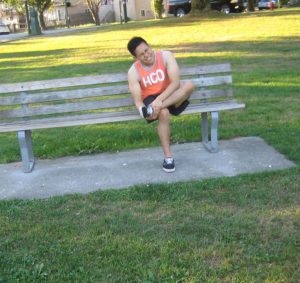Peroneal tendonitis is a condition characterized by structural changes of the peroneal tendon as a response to load. The tendons are connecting points between the bones and muscles. It is a painful condition of the foot and ankle due to repeated stress and strong force placed on the peroneal tendons and usually common among people playing volleyball, skiing, football and running on uneven surfaces.
Causes of peroneal tendonitis
- Wearing inadequate or unsupportive footwear
- A sudden increase in weight bearing activities especially walking, running or jumping.
- Imbalance of the muscles of the lower limb
- Poor biomechanics of the lower limb
- Improper rehabilitation of an acute ankle injury such as ankle sprain
Symptoms

- Pain when turning the foot in and out
- The ankle becomes unstable due to weight bearing
- Pain during and after performing weight bearing activities
- Gradual worsening pain on the outside of the ankle
- Severe pain when performing activities such as walking, running on uneven surface and minimizes after resting.
Treatment
- Take plenty of rest and avoid performing activities that causes pain in the affected area. Perform gentle exercises such as swimming without putting excessive stress on the affected area.
- Apply an ice pack on the affected area for at least 10-20 minutes every hour until the symptoms are reduced. Avoid applying the pack directly on the skin to prevent further damage and worsen the condition. Wrap the pack using a towel or piece of cloth before applying on the area.
- Take the prescribed anti-inflammatory medication such as ibuprofen to lessen the pain and inflammation.
- Elevate the affected foot above the level of the heart when sleeping or at rest.
- Wear properly fitting shoes appropriate for the biomechanics of the foot.
- Perform regular stretching with the help of a physical therapist. Stretch the peroneal calf muscle to prevent stiffness and tightness.
- Perform deep tissue massage and acupressure to lessen the tension in the peroneal tendon and relaxes the calf muscle after the massage.
- Once the swelling and pain lessens, gradually return to normal activities slowly.
Additional measures
- Wear an ankle brace on the first 2 weeks to prevent unnecessary movements and for fast healing of the condition. Another alternative is wearing a walking boot to lessen the tension on the tendon and allow easier walking.
- Soak the affected foot in a bowl filled witih sugarless carbonated water to lessen pain and inflammation for 2-3 times every day for best results. Another alternative is drinking carbonated water which is good for the health and keeps the body fresh.
- In a bucket filled with warm water, add 2 tablespoons of Epsom salt. Mix until salt is totally dissolved and soak the affected feet for at least 15-20 minutes. The magnesium sulfate found in Epsom salt replaces the lost magnesium in the foot and soothes the area. Repeat this process for several days for best results. Apply a moisturizer after to prevent dryness of the area.
Tips
- Perform proper warm up before starting an exercise.
- Wear proper supportive footwear.
FACT CHECK
https://www.foothealthfacts.org/conditions/peroneal-tendon-injuries
https://physioworks.com.au/injuries-conditions-1/peroneal-tendonitis
